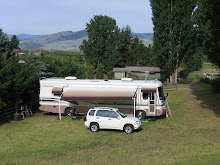Inuvik's Port on the Mackenzie River, once again the water front like the ferry landings are reshaped with heavy equipment after the spring run off each season. A barge on the left with living accommodations that can be moved to provide camps for working mine sites. A lot of equipment comes down the Mackenzie River from Hay River on Great Slave Lake in Alberta. Below there were four tugs and a barge not launched yet.
Because of the permafrost all buildings as the park models below have to be built above and off the ground on piles. Any building built on the ground would eventually melt the permafrost and the ground would heave underneath the building and it would buckle and lean.
Inuvik was conceived by the Canadian Government in 1953. It was intended to replace the hamlet of Aklavik in the Mackenzie Delta, which was subject to flooding and offered limited space for expansion. Originally it was named New Aklavik but this caused confusion for the delivery of mail and supplies, so the name Inuvik was selected in 1958. In Inuvialuktun it means "Place of People". The Arctic Ocean is only 97 kilometers north and the Arctic Circle is 200 kilometers to the south.
Inuvik has what is called the Utilidor System, no plumbing can be dug into the ground due to the permafrost as all plumbing would freeze. So this system carries the fresh water and sewerage pipes in a heated enclosed pipe to each house and building in the town.
As you can see this three story building built on legs and completely off the ground.
Smartie Box housing or known as Jelly Bean houses below.
Below the Community Greenhouse, a project that germinated in 1998, the facility (a conversion of an old arena) is the most northern greenhouse in North America and the only community greenhouse of its kind in the world. The purpose of the greenhouse is to ensure a more successful harvest and allow production of a greater variety of crops in an area where fresh economical produce is often unavailable. The building houses two areas: raised community garden plots available to residents and a 4,000 sq ft commercial greenhouse.










No comments:
Post a Comment